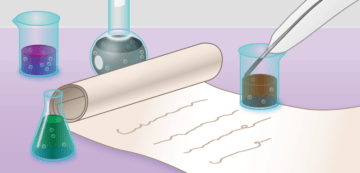Katherine Wright in Physics:
 Today, poetry and science are often considered to be mutually exclusive career paths. But that wasn’t always the case. The mathematician Ada Lovelace and the physicist James Clerk Maxwell were both accomplished poets who wrote rhymes about rainbows and verse about scientific societies. Conversely, the poet John Keats was a licensed surgeon. Combining the two practices fell out of favor in the 1800s, when science moved from a hobby of the elite to a legitimate profession. But translating research into lyrics, haiku, and other poetic forms is resurging among scientists as they look for alternative ways to inspire others with their findings.
Today, poetry and science are often considered to be mutually exclusive career paths. But that wasn’t always the case. The mathematician Ada Lovelace and the physicist James Clerk Maxwell were both accomplished poets who wrote rhymes about rainbows and verse about scientific societies. Conversely, the poet John Keats was a licensed surgeon. Combining the two practices fell out of favor in the 1800s, when science moved from a hobby of the elite to a legitimate profession. But translating research into lyrics, haiku, and other poetic forms is resurging among scientists as they look for alternative ways to inspire others with their findings.
“Poetry is a great tool for interrogating and questioning the world,” says Sam Illingworth, a poet and a geoscientist who currently works as a lecturer in science communication at the University of Western Australia. Through workshops and a new science-poetry journal, called Consilience, Illingworth is helping scientists to translate their latest results into poems that can attract appreciation from those outside of their immediate scientific sphere. “There are so many amazing science stories out there that people don’t know about because they are hidden in the jargon of scientific papers,” he says. “Poetry is a really powerful way to change that and to enable communication to take place.”
One scientist who has started using poetry as a communication tool is Stephany Mazon, who studies problems related to gas condensation in the atmosphere at the University of Helsinki in Finland. In May, Mazon joined one of Illingworth’s workshops, which took place via Zoom as part of the European Geophysical Union’s annual meeting. In the workshop, she, along with 300 other scientists, were split into groups of three. Each group was then tasked with writing a haiku, a 17-syllable-long poem that traditionally focuses on nature. Mazon was inspired to join the workshop, as she wanted to try her hand at this unconventional method of science communication. “We can’t all be Twitter stars,” she jokes. Her group only had a few minutes to come up with their haiku, which spotlighted water, a fluid that serendipitously featured in all of the group members’ research projects. “It was a lot of fun, and surprisingly easy to write the poem,” Mazon says.
More here.
